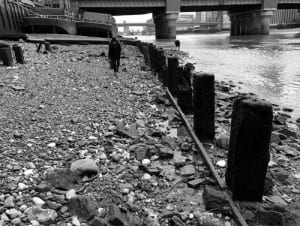How to make a diamond
By Jack Ashby, on 28 October 2015
This is a guest post from our artist in residence Eleanor Morgan. It is part of a series exploring the exhibition Glass Delusions at the Grant Museum of Zoology.
This year, on Thursday the 30th of July, I made a diamond. Only a few weeks before, this diamond had been floating around the River Thames in the form of dead plants and animals. It had taken a few hours, high pressure and temperature and most importantly a lot of help from UCL chemists and geologists to transform the dead creatures of the River Thames into tiny diamonds. These can now be seen at the Grant Museum as part of my exhibition Glass Delusions, along with a booklet ‘How to make a diamond’ which describes the process.
It began in January while I was walking along the foreshore of the River Thames looking for antique pots, glasses, metals and treasure. The river is filled with the stuff, so that at low tide some banks appear dark red from the fragments of roof tiles, bricks and pots discarded over the centuries.
Less noticed are the scattered animal bones, a pig’s jaw or a cow’s tooth, that mark the sites of the butchers and abattoirs that once lined the riverbank. There are other creatures too: rooks, geese, pigeons and seagulls all feast on the small delights exposed at low tide. Once I began looking, the Thames revealed a mass of organisms and their traces – hairs, furs, feathers, burnt wood, skin, and leaves. These are the unvalued creatures of the Thames, of little interest to treasure hunters. It was with this in mind that I decided to turn them into a diamond.
Diamonds are pure carbon, the same element as graphite – the material used to make pencils. The only difference between the two is the arrangement of the carbon atoms: graphite is made of flat sheets of carbon that slide over each other, while the carbon atoms in a diamond are linked together in a three-dimensional lattice. This structure is incredibly strong, which is why diamonds are the hardest natural substance on Earth. Carbon is found in minerals but also in all animals, plants, fungi and bacteria: it is one of the basic components of life. Because of this, diamonds can develop from both sources of carbon: rocks and organisms.
With my Tupperware box of dead organisms that I’d collected from the Thames, I went to see Prof Andrea Sella in the UCL Chemistry Department. With his help, we burnt the samples until we were left with the charred carbon remains. The next stage was to replicate the process of natural diamond making, but in quick time. Natural diamonds form over millions of years under high pressure and temperature, but since the 1960s it’s been possible to imitate this process in a laboratory – albeit at a smaller scale.
Working with Dr Ed Bailey in the UCL Earth Sciences Department, we put the carbon remains into a tiny furnace (2mm diameter). We then slotted this into a series of containers that increased in size, like a Russian doll, and placed it inside a giant press. We heated the furnace to 1600°C and set the pressure 4000 pounds per square inch (imagine a giraffe in stilettos stamping on a rock). It took just a few hours.
The next day, we began the quarrying process – taking apart each container until we came back to the centre. There were the sparkling minerals – bits of graphite and tiny diamonds that had once been living creatures floating in the River Thames.
Glass Delusions is an exhibition at the Grant Museum of Zoology, it is the end result of a year-long residency by artist Eleanor Morgan. It is open until 19th December 2015.
Eleanor Morgan is Artist in Residence at the Grant Museum of Zoology, funded by the Leverhulme Trust.
2 Responses to “How to make a diamond”
- 1
-
2
Gemma wrote on 27 November 2015:
Truly fascinating. I did also giggle a little which is always nice.lol I wonder if I can replicate and make my own diamond jewellery. Will save me a few pennies :).
 Close
Close





A fascinating story and one that might give an idea to members of the London criminal community. Deceased villains from the East End are often described in eulogies as being “diamond geezers” – well, now…